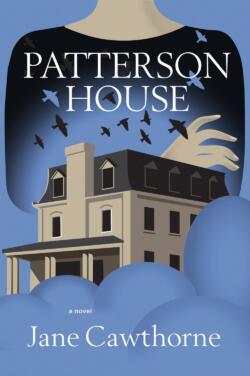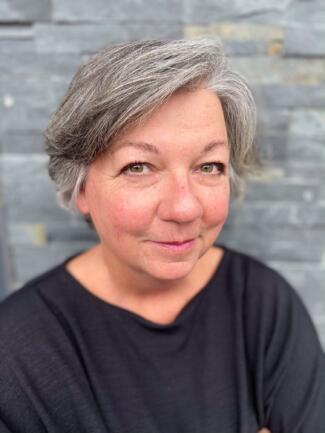Val's Book Reviews

Patterson House
by Jane Cawthorne
Toronto: Inanna Publications, 2022
$22.95 / 9781771339391

In her novel Patterson House, Jane Cawthorne has produced a warm yet tragic story of a once-wealthy Toronto family who still own a stately mansion known as Patterson House.
Cawthorne begins in 1873 with the ghostly voice of William Patterson, who has just committed suicide by hanging himself in the attic of the house. This event destroys the family name, his business, and the lives of his son, Rogers, two grandsons and granddaughter, Alden.
The story then jumps to 1916. Alden remains in the decaying house after her two brothers both die in the War; her father, Rogers, continues to allow the family business to go downhill. He turns to alcohol to cover the pain of losing his sons. After he dies, Alden becomes the last living member of the family and soon discovers that maintaining a large house is far from easy.
Earlier, on her way to a Temperance Meeting where she finds solace, Alden gets lost and wanders into the slum area of Toronto known as The Ward. She finds a baby left to die in the rubbish and is forced to decide about keeping the foundling. As there is no one willing to take the baby (and even the police do not seem interested in trying to locate the mother), Alden brings the girl home to Patterson House and names her Constance.
Between 1916 and 1954, the story follows Alden, Constance, and John Hunt, an injured war veteran and former gardener at Patterson House. He returns to the house a disfigured man and Alden takes him in. They are a strange trio who rely on one another but seem unable to express affection.

Their sad and painful stories bring a poignant beauty to this tale. As the two women fight to survive the lives that they have been dealt, Patterson House showcases the resilience of women in a man’s world. Their stories are interspersed with the ghostly voice of Alden’s grandfather, William, whose own past sins do not allow him to leave the house he built. His ghost lingers on unseen as he watches over the current inhabitants. Cawthorne’s delightfully different choice for a narrator complements an already beautifully written story. I found myself looking forward to hearing from William Patterson and knowing more about him and the wives that he cheated on.
Cawthorne’s writing flows and her characters come to life. There are passages that jump off the page. For instance, when Alden is expected to marry she’s already disillusioned. At a young age she discovered the man she imagined she loved (who ran the Temperance Society) was already married. One day she sits on the front steps of Patterson House and thinks about her life:
. . . she has Constance. Her penance, according to her father (as he falls into alcoholic oblivion). Her calling according to Father Moore (her Priest). Perhaps they are both right. But her penance for what? For her defiance? For wanting more than marriage to some podge of a man who is not her equal? For not being able to pretend that marriage is enough?
Alden wants more from life in an era when marriage alone was supposed to be enough for women.
Other strong characters come into the story, such as Constance’s only friend, Gwen, who is later abused by her step-father, and Gwen’s mother, yet another abused woman.

But Cawthorne’s story is not all doom and gloom. It shows another side of a dismal picture—the strength of women who learn how to survive against all odds. Alden, for instance, is forced to think up ways to keep Patterson House running—like taking in boarders while working her fingers to the bone with the help of Constance and John.
But when one particular boarder, Carling Grant, enters the scene, the story becomes even stronger and echoes the book’s opening scene. Cawthorne’s technique weaves the story’s many twists and turns into a strong, surprising ending.
In the final scene, Cawthorne jumps to October 1954. We learn about the fate of Patterson House and the comeuppance of William Patterson. This was a book I literally could not put down until that very last page—when I still wanted more.
Victoria’s Jane Cawthorne is an expert at writing about women in crises and she has published many short stories, essays, and a play on that subject. Her debut novel Patterson House captures historical Toronto, the city where she herself grew up.
Link to Original Review
“The Ormsby Review, named for pioneering historian and UBC professor Margaret Ormsby, is a remarkable and comprehensive online review of more British Columbia books than you ever imagined existing — the west coast publishing market is lively. It covers fiction, poetry, politics, memoir and much else, as well as a lot of local and west coast history.” – Christopher Moore, September 14, 2020.
Editor and Publisher: Richard Mackie
Mission Statement: The British Columbia Review, formerly The Ormsby Review, is a lively and inclusive Vancouver-based online journal devoted to the literature, arts, culture, and society of British Columbia. Our mandate is to review books by BC-based writers wherever they choose to publish them. We review books from the member publishers of the ABPBC (Association of Book Publishers of BC), but we also review books that are privately printed, self-published, or published by BC writers at publishing houses elsewhere in Canada or abroad. When possible, we also find BC reviewers. Our accessible and authoritative reviews and essays, written by experts in their fields, are packaged as illustrated magazine articles.
The British Columbia Review works with writers, publishers, and literary professionals across Canada to promote books published by BC writers or about British Columbia in all its diversity. We include books by all authors, regardless of race, age, ability, sexual orientation, gender or gender identity, ethnicity, religion, political belief, marital or family status, and/or status as Indigenous, Métis, or Inuit.
The editorial offices of The British Columbia Review are located near Commercial Drive in East Vancouver, in the traditional, unceded, and sometimes overlapping territories of the Musqueam, Squamish, and Tsleil-Wauuth peoples. Indigenous British Columbia, the land on which we live and create, extends over a large area comprising three culture areas, eight language families, and 32 distinct languages. We endeavour to review all books by and about Indigenous BC. Those reviews can be accessed directly here.
